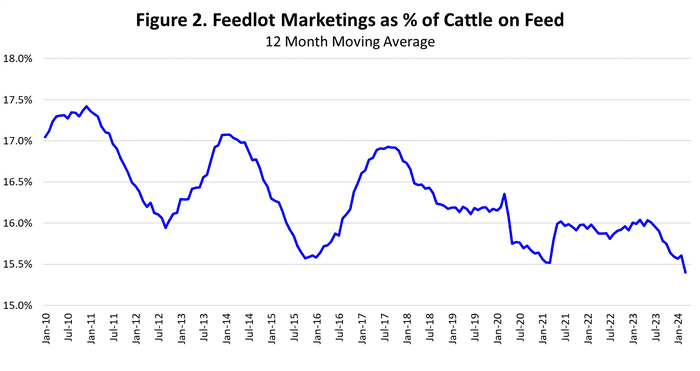Fewer cattle but more in feedlots
Posted on April 22, 2024
Source: Farm Progress. The original article is posted here.

The number of steers on feed April 1 was 7.266 million head, up 1.7 percent year over year and the heifers on feed inventory was 4.555 million head, up 1.1 percent from last year. Heifers made up 38.5 percent of total feedlot inventories, down from 39.7 percent in January. While the heifer percentage in feedlots remains above the average of the past ten years, the decline from January to April is an encouraging sign that heifer feeding is perhaps slowing. During rapid herd expansion in 2015-2017, the heifer percentage of feedlot inventories dropped below 34 percent and averaged below 33 percent for ten consecutive quarters, i.e. two and one-half years. Heifer feeding is expected to decrease significantly more in the coming months.
Feedlot placements
Feedlot placements in March were down 12.3 percent year over year, a larger decrease than expected. In fact, feedlot placements have been declining for many months in response to decreased feeder cattle supplies. Figure 1 shows that average monthly feedlot placements (12 month moving average) in March were at the lowest level since April 2017. Total placements in the last six months (October-March), which would account for the bulk of cattle currently in feedlots, is down 2.3 percent from the same period one year ago.

Marketings are down
How, then, can feedlot inventories be above year earlier levels as they have been for the last seven months? The answer is that feedlot marketing rates have fallen even faster than placement rates. Fewer cattle are staying in feedlots longer. In the latest cattle on feed report, March marketings were down 13.7 percent year over year, with monthly marketings just 14.4 percent of the March 1 feedlot inventory. Figure 2 shows the average (12 month moving average) feedlot marketings as a percentage of cattle on feed. Average feedlot marketings in March were 15.4 percent of feedlot inventories for the past twelve months, below 15.5 percent for the first time in data back to 1997.

Decline in feedlots
Feedlots have an incentive to keep inventories as close to capacity as possible. One way is to slow down the turnover rate effectively making fewer cattle turn into larger inventories. The result is more days on feed and heavier carcass weights. Steer carcass weights have averaged 25 pounds heavier year over year for the past four weeks, with heifer carcasses over 21 pounds heavier. There are limits to how much feedlots can slow marketings, but feedlots are expected to push carcass weights as far as possible in the coming months. Feedlot inventories are expected to decline in the next few months despite feedlot actions to delay the inevitable.

.jpg?disable=upscale&width=1200&height=630&fit=crop)


